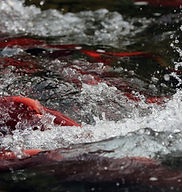Action Alert
- halshepherdwpc
- Oct 11
- 3 min read
Updated: Nov 9

Breaking News! The Graphite One Comment Period for the US Army Corp of Engineers Graphite One 404 permit has been extended to November 30:
If you haven't commented or your organization hasn't helped spread the word to drive public comments, please do so!
The Army Corp of Engineers is rushing to permit a large graphite mine in at the base of the Sacred Kigluaik Mountain range at the heart of the biologically and culturally rich Imuruk Basin Watershed.
Graphite One, a Canadian-based mining company, is applying for a federal permit for a 23,680 acre, year-round open-pit mine in Alaska’s remote Kigluaik Mountains. Also, to access what is likely the largest graphite deposit in the United States, the mining company proposes the construction of a 17.3-mile-long road cutting across salmon streams and archaeological sites and water withdrawals from over a dozen streams, further jeopardizing already low numbers of some returning salmon species at the exact time climate change is warming Arctic streams.
The outcome of the federal permitting phase for Graphite One will establish a precedent throughout Alaska for sacrificing sacred places and subsistence resources in exchange for resources. In the rush to mine graphite and other precious minerals, the analysis of the impacts of mining and other development activities is being fast-tracked, with little input to date from the Native communities most directly impacted.
Please use this sample letter to create your own comments and submit to the Army Corp of Engineers using the address provided:
Subject: Public Comment POA-2018-00210
Send to: Gregory.j.mazer@usace.army.mil
Dear Mr. Mazer,
I am writing to submit a public comment regarding Permit Application POA-2018-00210 for the proposed Graphite One open-pit graphite mine in the Kigluaik Mountains of Alaska.
I am deeply concerned about the potential environmental, cultural, and public health impacts this project poses to the region, particularly to the Alaska Native Tribal communities of Mary’s Igloo, Brevig Mission and Teller, which are located near the proposed site and along the Kougarok Road, the intended haul route.
I am also concerned that the application is being fast tracked under the federal Fast-41 process and Trump administration executive orders favoring industrial extraction activities over proper environmental analysis of impacts on water and subsistence resources. Similarly, while the Army Corps of Engineers appears to have been communicating with Graphite One about about the permit application no-such communication has occurred with regards to the application or jurisdictional determination regarding the application of the Waters of the U.S. Rule. Given these concerns, I respectfully request the following actions:
Extension of the public comment period from 30 days to at least 120 days, to ensure that all affected communities and Tribal governments have adequate time to review the project materials and provide input.
A full Environmental Impact Statement (EIS) in place of the currently proposed Environmental Assessment, due to the scale, duration, and potential risks of the project.
A public hearing conducted by the U.S. Army Corps of Engineers within the region, to allow community members, Tribal representatives, and local organizations to formally express their concerns and have them included in the public record.
4. Ensure meaningful tribal consultation and the inclusion of the Federally recognized Native Villages of Mary’s Igloo, Teller and Brevig Mission (Tribes) as Cooperating Agencies in the permitting process
Each of the Tribes have officially expressed opposition to this project. Their positions reflect the deep concern many residents share about potential harm to subsistence resources, water quality, and the long-term wellbeing of the land and people.
This project has far-reaching implications for the environment, for local and Tribal sovereignty, and for the future health of rural Alaskan communities. I urge the Corps to take these concerns seriously and to ensure that this process remains transparent, inclusive, and accountable.
Thank you for your time and consideration of these comments.
To learn more see: Protecting Subsistence Resources in the Imuruk Basin








Comments